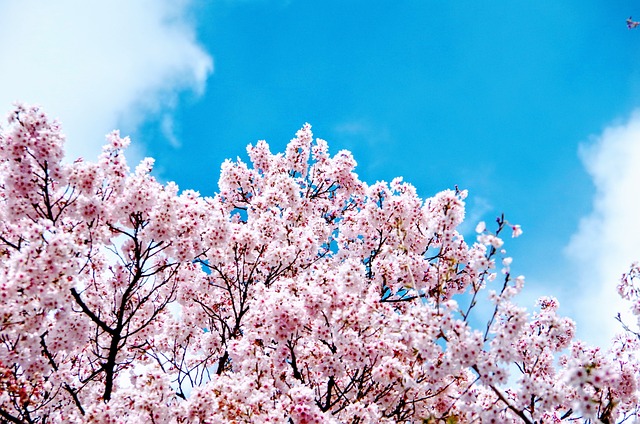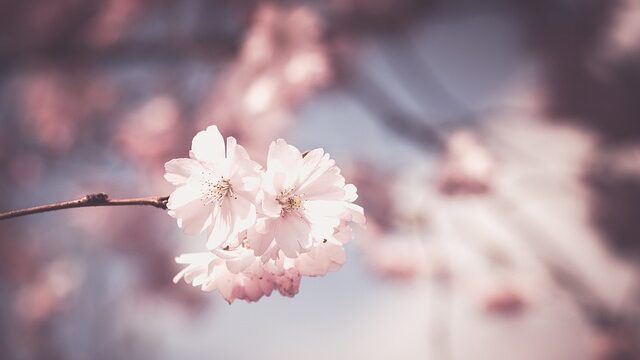Hanami, literally “flower viewing,” is the traditional Japanese custom of enjoying the ephemeral beauty of flowers, particularly cherry blossoms (sakura). This unique cultural event is a symbol of Japan’s aesthetic sensibilities, celebrating the fleeting beauty of life. Let’s delve into the world of hanami and guide you through the best ways to enjoy this springtime spectacle in Japan.
1. Hanami: The Celebration of Spring
Hanami, or cherry blossom viewing, is not just a tradition in Japan—it’s a symbol of the advent of spring and a nationwide celebration. While the tradition’s exact origins are unclear, it’s believed to have started in the Nara period (710-794) among the elite of the imperial court, inspired by the equally captivating yet transient beauty of ume (plum) blossoms. Over time, sakura, or cherry blossoms, with their profound symbolism and delicate beauty, became the center of this tradition, eventually spreading to samurai society and then to the common people.
A typical hanami party, known as a hanami picnic, involves laying out a picnic blanket under the blooming cherry trees and sharing food and drinks with friends, family, or coworkers. Often, these parties can continue into the evening—a practice known as yozakura, which involves illuminating the cherry trees to extend the viewing pleasure. During the cherry blossom season, you’ll find parks, temples, and schools filled with people appreciating the beautiful blossoms and enjoying their time under the trees.
In essence, hanami is a celebration of the ephemeral beauty of nature. The cherry blossom is a symbol of the fleeting nature of life in Japanese culture, its brief bloom serving as a poignant reminder of the transient nature of beauty and existence. This appreciation of momentary beauty aligns with many aspects of Japanese philosophy and aesthetics, such as the concept of mono no aware—a term that can be loosely translated as “the pathos of things” or “an empathy toward things.”
Furthermore, the event ties in with the Japanese Shinto belief of kami (spirits) residing in natural elements. Sakura trees were thought to house kami, and offerings were made at their base. Over time, this ritualistic offering transformed into the festive outdoor feasts we see today.
To experience hanami is to witness one of Japan’s most deeply ingrained traditions and join in the celebration of the fleeting beauty of life. It’s a testament to the country’s culture and a rich, fulfilling experience that transcends simple sightseeing. In the beauty of each petal and each shared laughter under the sakura trees, you partake in an event that celebrates life, camaraderie, and the passing of seasons in the Land of the Rising Sun.
2. Best Locations for Hanami
There are countless locations throughout Japan that provide breathtaking views of cherry blossoms during the spring season. Some spots, however, hold a unique charm that makes them popular among locals and tourists alike.
In Tokyo, one of the most well-known locations is Ueno Park, which hosts over 1,000 cherry trees. The sight of these trees in full bloom around Shinobazu Pond is truly a sight to behold. The park gets very busy during the sakura season, with both daytime hanami and yozakura celebrations, offering a vibrant atmosphere that is not to be missed.
Another notable location in Tokyo is the Shinjuku Gyoen National Garden, a large park that features more than a dozen varieties of cherry trees. This results in an extended blooming period and a multitude of colors, from white to different shades of pink. The park’s spacious lawns are perfect for hanami picnics.
Moving towards Kyoto, the Philosopher’s Path is a charming pedestrian path that follows a canal lined with hundreds of cherry trees. Named after Nishida Kitaro, a famous philosopher who is said to have practiced meditation while walking this route, this path provides a serene hanami experience away from the city’s hustle and bustle.
For a truly exceptional hanami experience, visit Hirosaki Park in Aomori, situated in the northern part of Honshu. The park, known for its Hirosaki Castle, boasts over 2,600 cherry trees and is considered one of the best cherry blossom spots in Japan. The sight of the castle, the cherry blossoms, and the unique floating lanterns on the moat at night provides a breathtakingly picturesque view that is imbued with history.
Another unique hanami location is Mount Yoshino in Nara, which is said to be the best cherry blossom spot in Japan. It has over 30,000 cherry trees planted on its slopes and offers panoramic views of the blossoming trees. This sea of pink and white sakura against the backdrop of Mount Yoshino’s natural beauty is truly a sight that will leave a lasting impression.
Lastly, don’t miss the Chidorigafuchi area in Tokyo, where you can rent a rowboat and paddle along a moat surrounded by cherry trees. This presents a unique opportunity to admire the blossoms from the water, providing a fresh perspective on hanami.
In choosing your hanami spot, consider the timing of the bloom, the crowds, and your personal preference for either a lively, festive atmosphere or a peaceful, tranquil experience. Remember, the beauty of sakura can be appreciated anywhere they bloom, so even a solitary tree in a neighborhood park can provide a memorable hanami experience.
3. Hanami Food and Drinks
A hanami celebration wouldn’t be complete without indulging in a variety of traditional Japanese foods and drinks. These delicacies not only provide sustenance for the day’s festivities but also play a significant role in the cultural experience.
The heart of hanami cuisine is the bento box—a traditional Japanese lunch box packed with an assortment of dishes. The contents of a hanami bento are colorful and varied, reflecting the joyous spirit of the season. It often includes sushi rolls, tamagoyaki (Japanese omelet), pickled vegetables, and onigiri (rice balls), among others. These foods are chosen not only for their taste but also for their ability to be eaten at room temperature, making them perfect for outdoor picnics.
Another staple of hanami is sakura-mochi, a pink-colored rice cake filled with sweet red bean paste and wrapped in a pickled cherry leaf. The slightly salty leaf contrasts with the sweet paste, resulting in a delightful balance of flavors. These sweets are often enjoyed with matcha (green tea), creating a quintessential Japanese combination.
During hanami, you’ll also find vendors selling various types of street food in parks and viewing spots. These can range from takoyaki (octopus balls) and yakitori (grilled chicken skewers) to sweet treats like taiyaki (fish-shaped cakes filled with red bean paste) and dango (sweet dumplings on a skewer). These street foods add a casual and fun element to the hanami dining experience.
As for drinks, sake—Japanese rice wine—is a traditional choice for hanami parties. The smooth flavor of sake complements the various foods and creates a festive atmosphere. Beer is also commonly enjoyed, and for those who prefer non-alcoholic beverages, a variety of soft drinks, tea, and amazake (a sweet, non-alcoholic sake) are available.
While indulging in these foods and drinks, it’s important to keep in mind the spirit of respect and appreciation that characterizes hanami. This means being mindful of cleanliness and taking care not to leave any trash behind. Many public parks provide garbage bins, and some even have designated areas for cooking and eating. It’s a part of the Japanese culture to respect public spaces, and adhering to these practices contributes to a more enjoyable and harmonious hanami experience for all.
4. Nighttime Hanami: Yozakura
Yozakura, literally “nighttime cherry blossoms,” presents an entirely different, yet equally enchanting perspective on hanami. As the sun sets, the cherry blossoms take on a new persona, illuminated by carefully placed lights in parks and along rivers. This practice of lighting up cherry blossom trees in the evening offers an experience that is romantic, magical, and often less crowded than daytime viewing.
Yozakura creates an ethereal ambiance that is somewhat more serene and tranquil than the day’s bustling festivities. The soft glow of the lanterns or spotlights enhances the pink hues of the sakura, making them stand out against the night sky. The contrast between the luminous blossoms and the darkness surrounding them highlights the transient beauty of the sakura.
Many cities across Japan hold yozakura events during the cherry blossom season, where parks, temples, and castles are lit up, adding an architectural backdrop to the glowing blossoms. For instance, Ueno Park in Tokyo, Maruyama Park in Kyoto, and Hirosaki Park in Aomori are known for their stunning yozakura displays.
For a truly unique yozakura experience, consider a nighttime cherry blossom river cruise. In cities like Tokyo and Kyoto, you can float down the river surrounded by illuminated sakura trees, providing an enchanting view from the water.
While enjoying yozakura, it’s customary to continue the feasting and drinking from the day’s hanami picnic under the illuminated trees. However, as the atmosphere at night is generally more tranquil, it’s considered polite to be quieter and more subdued than during the day.
Despite the drop in temperature after dark, many people consider the beauty of yozakura worth braving the cold for. So, put on a warm jacket, prepare a hot drink, and join in this beautiful tradition. The sight of cherry blossoms illuminated against the night sky is a spectacle you’ll remember long after your journey to Japan.
5. Hanami Etiquette
While hanami is a time for enjoyment and celebration, it is also important to uphold certain etiquette to ensure that the experience remains pleasant and respectful for everyone involved. These norms align with the Japanese cultural values of harmony, respect, and cleanliness.
Firstly, remember that cherry trees are a national treasure and are to be treated with respect. Avoid picking the blossoms or branches, as this can damage the trees. Climbing the trees is also frowned upon for the same reason. The beauty of sakura is to be admired and not disturbed.
Secondly, most hanami spots are public areas, so it’s important to be considerate of others. This means keeping noise levels to a minimum, especially during evening or nighttime viewing when the atmosphere tends to be more serene. Loud music or rowdy behavior can disrupt the tranquility that many people seek during hanami.
When it comes to securing a spot for a hanami picnic, keep in mind that it’s generally on a first-come, first-served basis. In some parks, people lay out picnic sheets early in the morning, or even the night before, to reserve a place under the cherry trees. If you see a sheet laid out with no one around, it’s a clear indication that the spot has been claimed, and it’s considered polite to find another location.
Food and drink are integral to hanami, but it’s crucial to maintain cleanliness. Many public spaces in Japan don’t provide trash cans, operating on a bring-in, bring-out policy. So, be prepared to take your garbage with you when you leave. Also, while it’s common to enjoy a drink during the festivities, public drunkenness is generally frowned upon.
Lastly, some parks have specific rules for hanami season, such as designated barbecue areas or prohibitions on using tarps to reserve picnic spots. Always check the rules of the park or viewing location beforehand to ensure you’re not unknowingly breaking them.
Observing these hanami etiquette guidelines contributes to a harmonious atmosphere and ensures that everyone can enjoy the beauty of the cherry blossoms. After all, the spirit of hanami is about appreciating the transient beauty of nature and celebrating the arrival of spring in a joyful and respectful manner.
6. Timing Your Visit: Sakura Forecast
Timing your visit to coincide with the sakura blooming season can be a bit of a challenge due to its ephemeral and unpredictable nature. The blooming period of cherry blossoms varies each year and is influenced by the winter’s weather and the transition into spring. However, thanks to decades of careful observation and advanced forecasting technology, Japan’s meteorological agencies can predict the approximate dates for the start of the bloom and full bloom in each region.
The sakura season typically starts in Okinawa, in the south, as early as January and gradually moves up the archipelago, reaching Tokyo and Kyoto usually by late March or early April, and then advancing to the northern regions like Hokkaido by early May. The entire blooming process, from the opening of the first buds (kaika) to full bloom (mankai), takes about a week. The full bloom also lasts about a week, followed by the graceful fall of the petals.
In Japan, the sakura forecast, or sakura-zensen, is eagerly awaited and is covered extensively by the media. These forecasts are usually first released in January and are updated regularly as the season approaches. While they provide a good guideline, it’s crucial to understand that these are predictions and the actual bloom can vary based on weather conditions leading up to the season.
If your travel dates are flexible, following the sakura forecast and planning accordingly can enhance your hanami experience. If you’re bound by fixed dates, don’t worry—there’s a chance you can still catch some blossoms, thanks to the various species of cherry trees that bloom at different times. For instance, the yaezakura, a variety with multiple layers of petals, blooms a couple of weeks later than the most common variety, Somei Yoshino.
Remember, while the blooming cherry blossoms are a spectacular sight, the anticipation of their bloom and even the fall of the petals carry their own unique beauty and symbolism. Every phase of the sakura lifecycle offers a reminder of the fleeting nature of life, echoing the Japanese concept of mono no aware, and is a sight to be appreciated.





